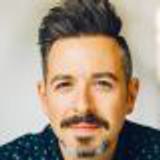
A Visual Tour Through the Basics of Social Media Marketing
The author's views are entirely their own (excluding the unlikely event of hypnosis) and may not always reflect the views of Moz.
I've been asked several times to give presentations on the basics of social media marketing, and have now refined my 15 minute introductory tour to the point where I think it's fairly good (and I'm really damn picky about my presentations). The following presentation (in visual and text form) should be helpful for anyone trying to convince their bosses, team or cohorts that investing in SMM is a worthwhile pursuit. Enjoy!
SECTION I: What is Social Media Marketing?
Before we ask that, we really need to start with the goals of online marketing as a whole!
- Basic Things Like:
- Web Site Traffic
- Conversions and Sales
- Page Views & Ad Exposure
- More Complex Things Like:
- Growing Brand Awareness
- Creating Positive Brand Association
- Business Development & Networking
Guess What? Social Media Marketing Can Help with All of These Things.
How, you might ask?
The first step is social interaction over the web. Platforms like Wikipedia (in the Web 2.0 world) or even forums and chatrooms (way back in the '90's) let ordinary users reach hundreds or thousands of other web-savvy people.
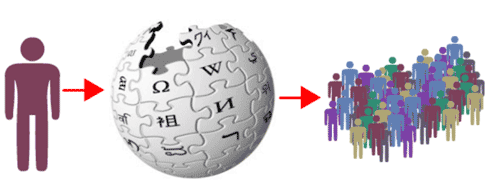
You + Wikipedia = Your Content in Front of Lots of Eyeballs
SMM also involves the practice of viral content creation and promotion. By building content on your website that's inherently alluring to a web-based audience, you can attract positive attention of all kinds.

In the example above, this singles map, showing the distribution of cities in the US with high/low men-to-women ratios, was "spread" across the web after it was promoted on Digg. The content's creator, National Geographic magazine, hadn't enabled the map to be visible in an online format, so the owner of a dating website actually re-published the image and built up a considerable amount of mindshare and relevant links.
Technical goals, like control of the search results to help with reputation management, are also a part of SMM's appeal. You can push down negative listings, swarm competitors, and build high ranking pages that can drive secondary traffic to your site(s).
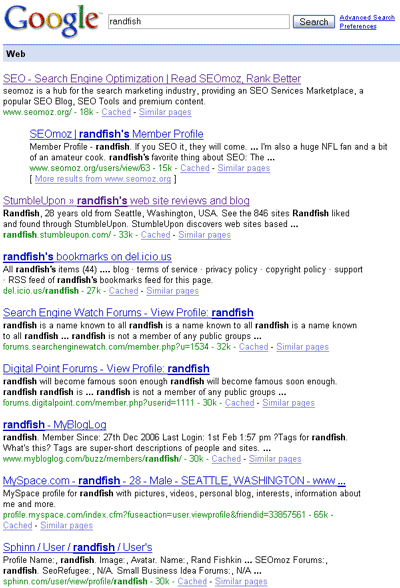
The image above shows the power of social media profiles - a search at Google returns pages and pages of my profiles at various sites where I'm a regular contributor (and plenty where I've barely contributed at all, too).
Social media's power lies in its ability to engage the "right" kind of participants. Key influencers are heavily overrepresented in social media (and the blogosphere), and immense value can come from getting your brand/content/product in front of their eyes.

SECTION II: Why is Engagement with Social Media Valuable?
Because social media supports both branding and mindshare goals
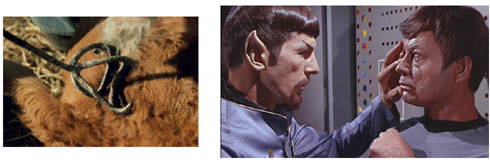
See? Branding on the left, mindshare on the right.
Social media participation can also bolster your search marketing goals. The engines want to see high quality, frequent, editorial links pointing to your site as a pre-requisite to rankings. The social web allows marketers to reach audiences who can provide these valuable links, giving them an edge on their less social competition.
SMM is also, obviously, great for traffic and even conversion rates. Social sites like Digg, Reddit, and popular blogs drive tens of thousands of visitors, and while those users frequently won't engage directly with your brand right away, they've now had a "branded experience" and are more likely to have positive associations and a brand memory in the future, both of which will serve to increase conversion rates.
SECTION III: Why Now? Why Has Social Media Suddenly Become So Important?
Because social media has suddenly become very, very popular.
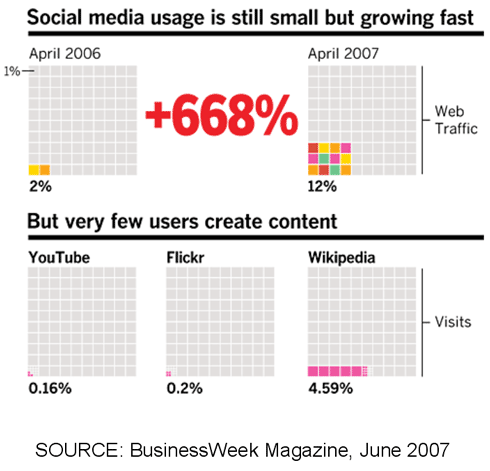
The chart above shows that year over year, 2007 was a breakout for user-generated content and participatory sites. The bottom half tells the story of opportunity - social media marketers have an opportunity to contribute and shape the social web before the noise of millions of users makes a single voice impossible to hear.
A few quotes from studies performed in the last 2 years stand out, including:
Brand Advocates have emerged online as primary influencers, with at least a two to one rate of converting an actual friend or family member to buy the same product or brand...
...Brand Advocates are incredibly valuable to marketers because they are better connected consumers with a larger sphere of influence...
...Social Media is the Key – Study findings showed that Brand Advocates are taking full advantage of social media tools and actively leveraging them for product purchases. Through instant messaging, chat, community, photo sites and blogging, Brand Advocates are able to influence their vast online social circle...
Source: Yahoo! + ComScore Study on Brand Advocates - December 2006
Passionistas heavily engage with communities of like-minded consumers who use email, text messaging, and instant messaging significantly more than typical users, and are more likely to create and share user-generated content online such as photos, blog posts or videos about their passions. Because of their intense engagement around sharing information about their passions through digital media, Passionistas are natural brand advocates and 52% more likely than typical users to recommend or influence others about brands aligning with them.
Brands that stimulate conversation among passionate consumers will be rewarded through the credibility that comes from trusted word of mouth,” said Jim Kite, President of Connections Research and Analytics at MediaVest. “Accessing Passionistas online also offers the ability to track this valuable group’s media consumption habits, enabling brands to optimally – and accountably – leverage their advocacy power.
Source: Yahoo! Passionistas Report - September 2007
If that doesn't convince you, read on:

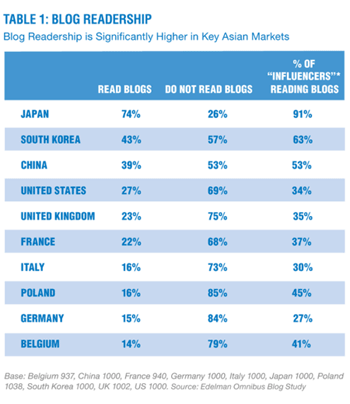
It's not surprising for most Internet users to find that influencers of all varieties are heavily engaged with the web in general (and the blogosphere in particular), but it's amazing to imagine that US influencers are actually trailing countries like China, South Korea, & Japan in blog engagement.
SECTION IV: How Does SMM Help with SEM?
Remember back to a time long ago when search engines weren't too smart? There it is - just about 1997. Altavista and Lycos and NorthernLight were scanning keywords and meta tags, trying to sort out who repeated the phrase "dancing baby gif" the most.
Obviously, these primitive engines didn't last long, and with the evolution and popularization of link-based algorithms, search engines became smarter. However, the gaming continued. Once search marketers learned of the biases towards links, the Internet starting flooding with "non-editorially given links" based on a desire to manipulate the rankings of the engines. These links were never intended to be clicked, and the motivations behind them weren't to "endorse the quality or relevance of another site's content."
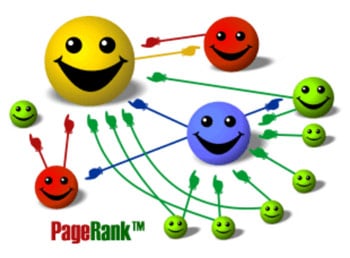
The "links as votes" algorithms could only persist so long as links were truly meant as votes - and with the Pandora's box of PageRank spilling across the web, the search engines had to resort to better and more careful analyses of which links to count. Thus, they developed advanced algorithms for calculating trust, segmenting pages, watching for spikes of unnatural link activity, and generally cramping down on the search world's less cautious manipulators.

With tactics like link farms, reciprocal schemes, paid link networks,and forum, guestbook, and blog spamming all going the way of the Dodo, websites that wanted to rank atop the engines needed to return to the roots of organic marketing. This re-ignited the age old conflict of the marketer vs. the trusted source - how does a company get their product or service in front of the right people to let it spread editorially?
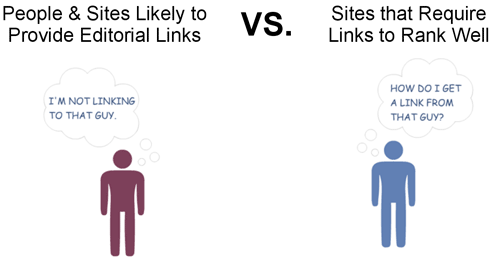
This phenomenon brings us to a string of fundamental questions... and their answers
#1 - Who Creates Links on the Web?
Oh, right... It's these guys:
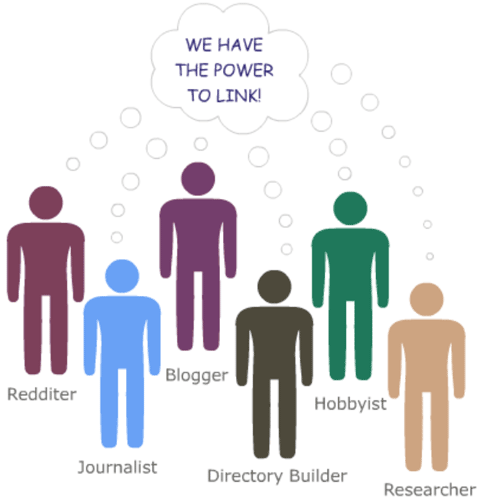
I like to call them the Linkerati, but they are, in essence, merely an extension of the offline world's influencers - journalists, traveling salesmen, and your neighbor Jessica, who always has some new remarkable product or company to tell you about. The Linkerati are powerful - they own the editorially given link structure of the web, and this brings us to our second question...
#2 - How Can Marketers Reach the Linkerati?
Oh, right... Social Media Marketing! Through the sites and blogs that Linkerati frequent and are influenced by, we can build a marketing campaign that uses content-based strategies to get in front of the right people. But, is getting in front of them enough? Can we play a passive role once our brand has been seen? Or, do we need to do something more - perhaps ask another question.
#3 - How Do Influencers Spread Content?
Oh right... We're going to need to know this if we want our Linkerati to socially spread our ideas. Lucikly, I've got this handy bullet point list:
-
Email to friends and associates
-
Share via social networking sites (Facebook, MySpace, LinkedIn)
-
Vote up at social news portals (Digg, Reddit, Newsvine, Mixx, Propeller)
-
Link to from Blog posts and comments
-
Discuss at forums and groups
-
Spread via word-of-mouth directly to colleagues and contacts
-
Link to on their websites
-
Broadcast via multimedia (video, podcasts)
-
Mainstream media (TV, radio, newspapers, magazines)
Not all of these are inherently trackable, but many of them are, and by measuring successes against failures in the online world, we'll be able to get a sense of what plays with the Linkerati.
#4 - What Types of Content Are Likely to Become Viral?
This final question comes after months and years of experience and in many cases, its uniquely tailored to your specific industry or niche. Luckily, we're not really going to leave you hanging - Jane's new linkbait guide is out today, and although it's part of our premium content, it does a fantastic job of explaining the ins and outs of why some content succeeds while others falter. In the interim, this chart is pretty useful, too:

Hopefully, you've enjoyed this social media basics presentation in blog format. For those who'd prefer, you can download the whole thing in Microsoft Powerpoint here as well.
p.s. I did not end up giving this presentation at Pubcon Las Vegas - instead, I asked the audience to vote between this and a more advanced walkthrough of social media sites, and more than 90% opted for the latter. I've asked that no one blog or reveal the contents therein, but we will have it available for download behind the premium content curtain at the request of a very smart audience member :)



Comments
Please keep your comments TAGFEE by following the community etiquette
Comments are closed. Got a burning question? Head to our Q&A section to start a new conversation.